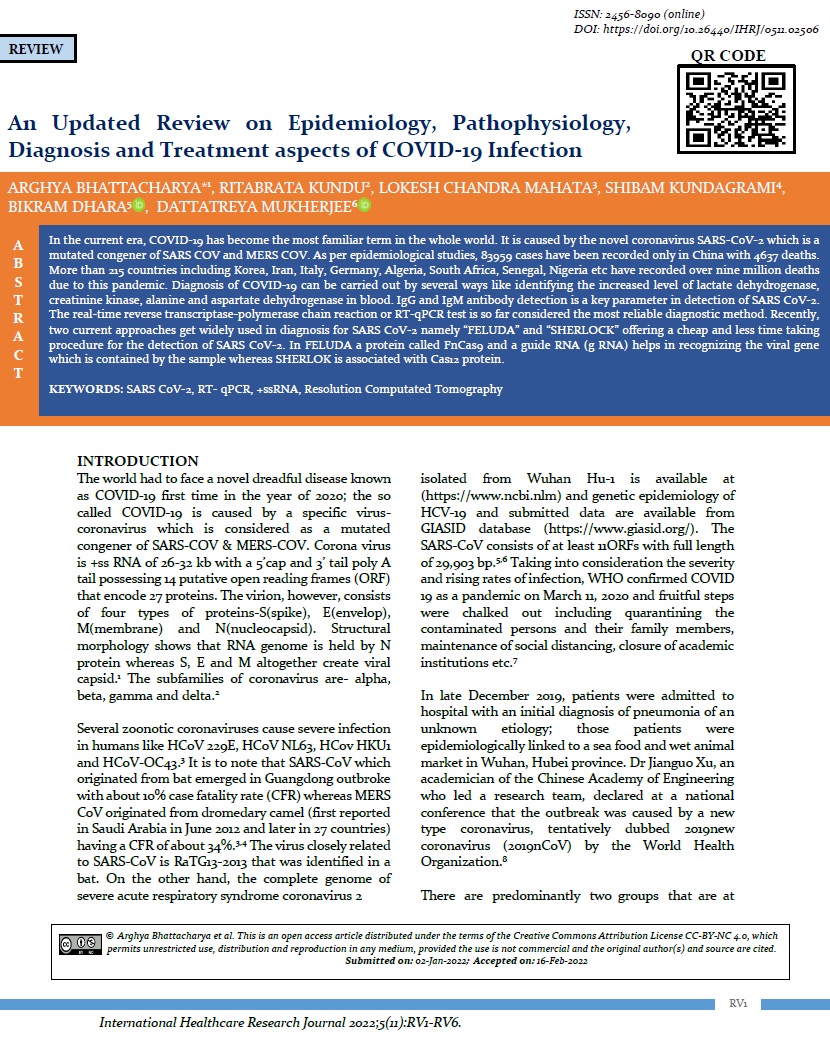An Updated Review on Epidemiology, Pathophysiology, Diagnosis and Treatment aspects of COVID-19 Infection
Abstract
In the current era, COVID-19 has become the most familiar term in the whole world. It is caused by the novel coronavirus SARS-CoV-2 which is a mutated congener of SARS COV and MERS COV. As per epidemiological studies, 83959 cases have been recorded only in China with 4637 deaths. More than 215 countries including Korea, Iran, Italy, Germany, Algeria, South Africa, Senegal, Nigeria etc have recorded over nine million deaths due to this pandemic. Diagnosis of COVID-19 can be carried out by several ways like identifying the increased level of lactate dehydrogenase, creatinine kinase, alanine and aspartate dehydrogenase in blood. IgG and IgM antibody detection is a key parameter in detection of SARS CoV-2. The real-time reverse transcriptase-polymerase chain reaction or RT-qPCR test is so far considered the most reliable diagnostic method. Recently, two current approaches get widely used in diagnosis for SARS CoV-2 namely “FELUDA” and “SHERLOCK” offering a cheap and less time taking procedure for the detection of SARS CoV-2. In FELUDA a protein called FnCas9 and a guide RNA (g RNA) helps in recognizing the viral gene which is contained by the sample whereas SHERLOK is associated with Cas12 protein.
Downloads
References
Shereen MA, Khan S, Kazmi A, Bashir N, Siddique R. COVID-19 infection: origin, transmission, and characteristics of human coronaviruses. Journal of Advanced Research 2020;24:91–8. https://doi.org/10.1016/j.jare.2020.03.005
World Health Organization, Laboratory testing for coronavirus disease 2019 (COVID-19) in suspected human cases, World Health Organization, 2020.
Zhong NS, Zheng BJ, Li YM, Xie ZH, Chan KH, Li PH, Tan SY Chang Q, Xie JP, et al. Epidemiology and cause of severe acute respiratory syndrome (SARS) in Guangdong, People’s Republic of China, in February, 2003. Lancet. 2003;362(9393):1353–8.
Haagmans BL, Al Dhahiry SH, Reusken CB, Raj VS, Galiano M, Myers R, Godeke GJ, Jonges M, Farag E, Diab A, et al. Middle East respiratory syndrome coronavirus in dromedary camels: an outbreak investigation. Lancet Infect Dis. 2014;14(2):140–5.
Sohrabi C, Alsafi Z, O'Neill N, et al. World Health Organization declares global emergency: A review of the 2019 novel coronavirus (COVID-19) [published correction appears in Int J Surg. 2020 Apr 15;:]. Int J Surg. 2020;76:71‐76. https://doi.org/10.1016/j.ijsu.2020.02.034.
Zhang T, Wu Q, Zhang Z. Probable Pangolin Origin of SARS-CoV-2 Associated with the COVID-19 Outbreak [published correction appears in Curr Biol. 2020 Apr 20;30(8):1578. https://doi.org/10.1016/j.cub.2020.03.022.
Organization WH: WHO Timeline—COVID-19. 2020. (Online Article). Available fomr: https://www.who.int/news-room/detail/27-04-2020-who-timeline—covid-19. [Last Accessed on 15th
December, 2021.]
Lu H, Stratton CW, Tang YW. Outbreak of pneumonia of unknown etiology in Wuhan, China: The mystery and the miracle. J Med Virol. 2020 Apr;92(4):401-402. https://doi.org/10.1002/jmv.25678.
Wang B, Li R, Lu Z, Huang Y. Does comorbidity increase the risk of patients with COVID-19: evidence from meta-analysis. Aging (Albany NY). 2020;12(7):6049‐57. https://doi.org/10.18632/aging.103000.m
World Health Organization, “Coronavirus disease 2019 (COVID-19): Situation Report 61,” March 2020, (Online Article) Available from: https://www.who.int/emergencies/diseases/novel-coronavirus-2019/ situation-reports. [Last Accessed on 15th December, 2021]
Donnelly CA, Ghani AC, Leung GM, et al. Epidemiological determinants of spread of causal agent of severe acute respiratory syndrome in Hongkong. Lancet 2003;361:1761–6.
Jiang S, Du L, Shi Z. An emerging coronavirus causing pneumonia outbreak in Wuhan, China: calling for developing therapeutic and prophylactic strategies. Emerg Microbes Infect. 2020 Jan 31;9(1):275-277. https://doi.org/10.1080/22221751.2020.1723441.
Hoffmann M, Kleine-Weber H, Schroeder S, et al. SARS-CoV-2 cell entry depends on ACE2 and TMPRSS2 and is blocked by a clinically proven protease inhibitor. Cell 2020;181(2):271-80. https://doi.org/10.1016/j.cell.2020.02.052
Cascella M, Rajnik M, Cuomo A, et al., Features, evaluation and treatment coronavirus (COVID-19). Stat pearls [internet]. Treasure Island (FL): Stat Pearls Publishing, Jan 2020.
Sikachi R, Agrawal A. Whole body point of care ultrasound for COVID-19: a multisystem approach to a multi-system disease [published online ahead of print, 2020 Apr 16]. Anaesthesia. 2020;10.1111/anae.15087. https://doi.org/10.1111/anae.15087
Azhar M, Phutela R, Ansari AH, et al. Rapid, fielddeployable nucleobase detection and identification using FnCas9. bioRxiv. 2020. https://doi.org/10.1101/2020.04.07. 028167
van de Veerdonk FL, Netea MG, van Deuren M, et al. Kallikrein-kinin blockade in patients with COVID-19 to prevent acute respiratory distress syndrome. Elife. Published online April 27, 2020.
Li W, Moore MJ, Vasilieva N, et al. Angiotensin-converting enzyme 2 is a functional receptor for the SARS coronavirus. Nature 2003;426:450–4.
Tang NL, Chan PK, Wong CK, et al. Early enhanced expression of interferon-inducible protein-10 (CXCL-10) and other chemokines predicts adverse outcome in severe acute respiratory syndrome. Clin Chem. 2005;51:2333–40.
Xu Z, Shi L, Wang Y, et al. Pathological findings of COVID-19 associated with acute respiratory distress syndrome. Lancet Respir Med. 2020;8:420–2. https://doi.org/10.1016/S2213-2600(20)30076-X
Ganyani T, Kremer C, Chen D, et al. Estimating the generation interval for coronavirus disease (COVID-19) based on symptom onset data, March 2020. Euro Surveill. 2020;25(17). https://doi.org/10.2807/1560-7917.ES.2020.25.17.2000257
Tchesnokov EP, Feng JY, Porter DP, et al. Mechanism of inhibition of Ebola virus RNA-dependent RNA polymerase by remdesivir. Viruses 2019;11:326. https://doi.org/10.3390/v11040326
Bacharier LB, Guilbert TW, Mauger DT, et al., Early administration of azithromycin and prevention of severe lower respiratory tract illnesses in preschool children with a history of such illnesses: a randomized clinical trial. JAMA 2015;314:2034–44.
The Mint. Coronavirus vaccine update: Nod to human trial marks 'beginning of the end’, says govt. (Online Article). Available https://www.livemint.com/news/india/coronavirus-vaccine-nod-to-humantrial-marks-beginning-of-the-end-says-govt-11593961927406.html [Last Accessed on 15th December, 2021]
Clinical Management Protocol of COVID 19 Government of India, Ministry of Health and Family Welfare. Online PDF. Available from: https://www.mohfw.gov.in/pdf/ClinicalManagementProtocolforCOVID-19.pdf [Last accessed on 20th June 2021)
Yang Y, Islam MS, Wang J, Li Y, Chen X. Traditional Chinese medicine in the treatment of patients infected with 2019-new coronavirus (SARS-CoV-2): a review and perspective. International Journal of Biological Sciences 2020;16(10):1708–17. https://doi.org/10.7150/ijbs.45538
Buonaguro FM, Puzanov I, Ascierto PA. Anti-IL6R role in treatment of COVID-19related ARDS. J Transl Med. 2020;18:165. https://doi.org/10.1186/s12967-020-02333-9

Copyright (c) 2022 Arghya Bhattacharya et al.

This work is licensed under a Creative Commons Attribution-NonCommercial 4.0 International License.


